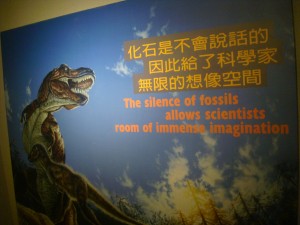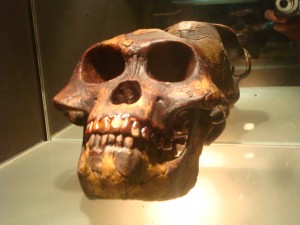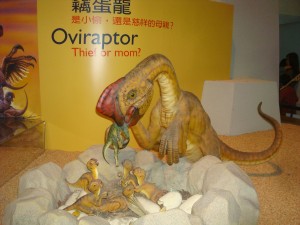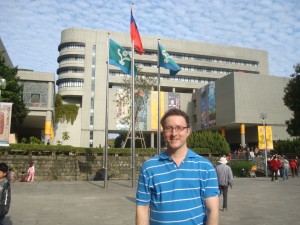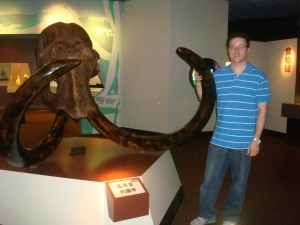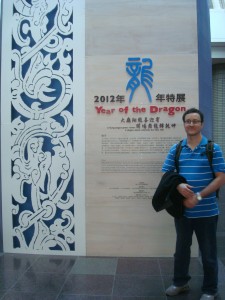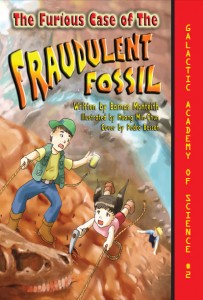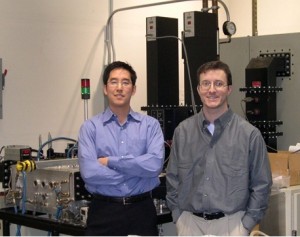Have you been eating your mammoth bones lately?
Leading up to THL’s first Chinese language science learning book releases in Asia at the Taipei International Book Expo, as well as the opening of our new office on ZhongXiao E (Dong Lu), Houshanpi, Taipei, THL staff have been busy at work on preparations in Taiwan, throughout the New Year. 2012 – the year of the Dragon (龍) – is significant for Tumblehome Learning, as ‘fraudulent dragon fossils’ are a key theme in several of the inaugural books produced by THL this year, including the Furious Case of the Fraudulent Fossil, and Dinosaur Eggs & Blue Ribbons, both authored by Barnas Monteith.
Dinosaur, in English, originally named by Sir Richard Owen (1804-1892), is derived from the Greek words deino, meaning “fearfully great” and sauros meaning “lizard”; however in the most widely spoken language in Asia, Mandarin Chinese, the word Dinosaur is translated as “kong lung” (恐龍), which means “fearful dragon”. Dragons and dinosaurs have long been closely affiliated in Asian cultures in more ways than just their names; for hundreds of years, dinosaur and other vertebrate animal fossils, often darkly colored, were thought to be the charred and hardened stone bones of long-dead mythical dragons. As such, they were thought to have mystical healing properties and were revered by doctors and people with severe illnesses, not knowing that they were actually fossils of dinosaurs, reptiles, amphibians and even birds from millions, even hundreds of millions of years ago (this is even document in ancient text such as the Shennong Bencao Jing, ca. 100 AD). These “fraudulent dragon bones” were often crushed into powder and prepared in teas, and mixed into foods, in an attempt to use the magic of the dragon bones to heal the wounded and sick. Needless to say there were very few people truly healed by these dragon bones, but yet, even to this day the practice of using dinosaur bones in Eastern medicine still continues.
It is a lesser known story that the origin of mankind, and the study of human evolution, was first discovered in a pile of these so called “dragon bones”. Peking Man (Sinanthropus pekinesis, named afterBeijing, once known as Peking), is known to be an early ancestor of homo sapiens (man). In the late 1800’s, many paleontologists, rather than going out and digging in the field, would instead visit Chinese pharmacies, knowing that some of the best finds could be had in the dragon medicines. German physician, Dr. KA Haberer picked up a number of fossils on a trip to a Beijing pharmacy in 1899, and unbeknownst to him, also picked up a 2 million year human-like molar, which it was later determined was that of the Peking Man, a very early ape-like ancestor of man — and additional parts were later found on subsequent expeditions to a limestone quarry location just south of Beijing known as “Chou Kou Tien” or “Dragon Bone Hill”. Important fossils continue to be found to this day, in remote apothecaries throughout Asia.
In Fraudent Fossil, students learn of a modern day fraudulent fossil mystery, which they must solve by going back in time to visit and learn from historically significant geologists, naturalists and other scientists who helped to shape the ideas which have evolved into modern paleontology. One such scientist/naturalist was Shen Kuo (沈括, 1031-1095) a high ranking Song Dynasty statesman who discovered the concepts of geomorphology and stratigraphy, while viewing the bamboo-like plant fossils found in different rock layers of the Taihang Mountains in Wenzhou, China. Shen’s idea of how rocks and mountains were formed predated the concepts of sedimentology and rock formation described by James Hutton in 1802, which has often been referred to as the work which defined modern geology. Geomorphology (the study of the shapes of landscapes and land formations) and sedimentary deposition / stratigraphy (how smaller rocks such as mud particles are joined together to make larger solid rocks like mudstone and slate over time, and then form layers) are perhaps the most crucial tools used by geologists & paleontologists to utilize in studies of evolution (e.g. dating fossils to determine whether or not they are truly “missing links” – not to mention their validity as real fossils). Students also explore the world of Roy Chapman Andrews – an adventuresome American paleontologist and explorer often referred to as the real world basis for the movie character “Indiana Jones”. Roy Chapman Andrews (1884-1960) also visited China to hold expeditions in the Gobi Desert of Montana to try to find more clues about the history of early mankind, and to find evidence of missing links even earlier than “Peking Man”. However, instead, Roy Chapman Andrews became the very first paleontologist to uncover dinosaur eggs, and to describe in significant detail some of the behavioral characteristics of dinosaurs which could be inferred from fossils.
In Dinosaur Eggs & Blue Ribbons, Barnas Monteith digs deep into the world of modern paleobiology and the various advanced biochemistry techniques used today to uncover and compare ancient proteins, while offering tips and advice about how to succeed at winning science fairs. In the story, Barnas discusses his adventures as a young student of paleontology doing field research for his science fair project in the badlands ofMontana, under the guidance of famed paleontologist Jack Horner, a MacArthur Genius award winner, and the model behind the lead character inJurassicPark. Jack Horner’s work on dinosaur egg placement suggesting material nesting behaviors in Maiasaurs over60 m.y.a. were cutting edge in the1970’s and80’s, and Dr. Horner has continued to innovate new fields of paleontology. A number of years ago, Jack led a team of researchers to uncover proteins from a highly well preserved T-rex bone, which was so well fossilized, that some organic materials and possibly even cells of T-rex blood, actually remained within the bone. In recent years, Jack has been doing significantly more fieldwork in Asia, where a plethora of bird fossils and new nesting grounds continue to be found on a frequent basis; as a result of all this new data, Jack has come up with various new theories and ideas to support the idea that dinosaurs were incredibly bird-like and that dinosaur-like reptiles very likely evolved into birds. One of Dr. Horner’s ideas involves the concept of genetically “reverse engineering” dinosaurs from chicken DNA; so far, he has already been able to get a normal chicken to grow a small dinosaur-like tail by simply awakening old “extinct” genes. And he is not the only one working to revive extinct DNA – it was announced in 2011 that Japanese scientists have begun work on resurrecting 8,000 year old Woolly Mammoths, and expect work to be completed within 4 to 5 years. Scientists hope to revive DNA from intact If research advances as predicted, it may be possible to have a real woolly mammoth walk into the Smithsonian Museum of Natural History in Washington D.C. before the 2017 U.S. Presidential inauguration (for those of you who haven’t been there before, there is a giant woolly mammoth centerpiece which greets you, as you enter the lobby of the museum; museums are among the best ways to get children interested in science by the way, as can be seen in the most recent previous THL blog – by THL cofounder Penny Noyce).
Taiwan’s own Taichung Museum of Natural Science, one of the largest and most well attended museums in the country, is home to an amazing collection of fossil elephants, mammoths, rhinoceros, and other mammals found throughoutTaiwan. The Taichung MNS held a special mammoth exhibit in 2009, to display elephant and mammoth finds fromTaiwan, as well as from around the world, includingSiberia. Although Taiwan’s climate does not permit permafrost in most areas and therefore can not offer a good preservation environment for genetic material, the mammal fossils in TW are very well preserved, and have been described as early as the1920’s by Japanese paleontologists, as being related to other fossils found in mainland China, as well as in Japan. Most of these animals are from the recent Ice Ages,10’s of thousands of years ago. A recent study by scientists at a traditional medicine center in Oregon have determined that a variety of randomly sampled “Chinese medicines” are in fact fossils of elephants, woolly mammoths (Stegodon) and rhinoceros – very similar to the profile of fossils found in Taiwan. Who knows how many mammoths have been mistakenly consumed as “dragon bones” throughout time, acrossTaiwan, and throughout Asia?
One thing is for certain: the dragon is an important mythical cultural symbol throughoutAsia, and their real counterparts – dinosaurs – will be a key feature in THL’s 2012 book catalog. This year, THL will celebrate the Year of Dragon by releasing a minimum of 3 books focused on paleontology; and will be building a major presence in Asia, the original home of the Dragon.
Don’t forget the next time you get ill, be sure to eat all your “dragon bones”…
If you happen to be in Taipei currently or in the near future, please visit THL’s booth at the Taipei International Book Expo from Feb 1-6, 2012, at the Taiwan World Trade Center (details on our events page), or visit our new Taipei office at ZhongXiao DongLu (please set up an appointment via our contact page).
Be sure to buy the new copy of Barnas’ book “The Furious Case of the Fraudulent Fossil”, now also available in Traditional Mandarin Chinese:
This Chinese translation of the book is soon to be released in Taiwan:
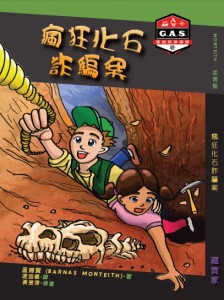
This is what the new Traditional Chinese version (瘋狂化石詐騙案) of the Fraudulent Fossil looks like; Mandarin editions are not currently available at the THL, check back later, in the meantime, please buy an English edition

